|
Paper 15
G.M.S. Chivers, Dancing Master
Contributed by Paul Cooper, Research Editor
[Published - 20th July 2015, Last Changed - 26th December 2024]
In previous papers we've studied two important Regency era Dancing Masters, Thomas Wilson and Edward Payne. We've also studied two major band leaders, James Paine and Joseph Hart.
In this paper we'll study a third Dancing Master, G.M.S. Chivers. George Chivers wasn't particularly prominent in his own era yet he left behind him the most extensive collection of contemporary dance publications of any writer other than Thomas Wilson. His works help to inform our understanding of English social dancing in the late Regency and 1820s. In this paper we'll consider his dances, his academy, his publications and his great rivalry with Thomas Wilson.
Figure 1 shows an 1822 image of Chivers. He included it in his 1822 Modern Dancing Master and his c.1823 First Set of Chiverian Quadrilles.
Chivers' Academy
The earliest advertisement for Chivers' academy I've found was published in Bell's Weekly Messenger for the 21st December 1817. It begins: Mr CHIVERS, (late of the King's Theatre, Opera House), most respectfully tenders his services for the Instruction of Persons of any age, in Quadrilles, Country Dancing, Waltzing, Minuets, &c &c; which are taught with ease, elegance, and vivacity, at his select Academy . Almost a year later another advertisement was published in The Morning Post (13th November, 1818). It reads:
Waltzing, Ecossoises, Quadrilles, Spanish Dancing, Minuets, La Grand Polonaise, Gavottes, Country Dances, Swedish Dancing &c -- Mr CHIVERS, late of the King's Theatre Italian Opera House, gives PUBLIC or PRIVATE LESSONS and PRACTICE in the EVENING, from Eight till Ten, or Nine till Eleven, or any hour of the day, MONDAYS, WEDNESDAYS, and FRIDAYS. Mrs Chivers superintends the ladies in a separate apartment. Families attended. Professors taught any department, and the greatest secrecy observed. Cards had at Mr Chivers' Academy and Assembly Rooms, No 5 Pickett-Place, Temple bar; where may be had A Companion to the French and English Dancing , also the Swedish Dances (which Mr C. has introduced into this country; its simplicity and elegance surpasses all others, and is well adapted to parties having a majority of either sex.) The Rooms may be had occasionally, which have accomodation for 200 persons.
It's clear that Chivers had a successful business prior to the publication of these adverts. The 1818 advertisement lists much of his repertoire, including some new dance forms that he'd invented; it mentions that two of his books were already published and it advertised his academy. We also learn that his wife was a partner in the business and that she offered private dancing lessons to the ladies.
Chivers, much like Thomas Wilson before him, emphasised that he'd worked at the King's Theatre Opera House. The nature of his employment there isn't clear, it was however sufficient to boast about. In all probability he was a stage performer who turned to dance tuition when his stage career came to an end. His address that was given to be at 5 Pickett-Place is perhaps a misprint, all subsequent advertisements indicate he was based at 7 Pickett-Place .
A separate advert for his academy in the 1818 Companion to the French and English Country Dancing indicates that he offered both Monthly and Quarterly payment plans and taught Quadrilles, Waltzing and Country Dances. A further advert from 1819 (The Morning Chronicle, 4th March, see Figure 2) added some new dances to the repertoire, Le Mescolanze... also Fancy Dances taught . He also promised secrecy to any professors of dancing who wished to study under him and offered his attendance at Quadrille Parties. A little later (The Morning Chronicle, 17th June 1819) he added the Hornpipe to his advertised repertoire, later still (The Star, 11th December, 1819) he offered to teach Paine (of Almack's) Quadrilles (the Quadrilles of James Paine) and the Violin .
His adverts from 1820 refer to the academy as his Salle de Danse (The Observer, 23rd January); this is the same phrase the dancing master Edward Payne used for his equivalent dancing academy from 1818. The address of this renamed academy remained at 7 Pickett Place , though an advert for a Mr Roland, Fencing Master of the Royal Military Academy indicates that the premises was shared (The Morning Chronicle, 29th January 1820); dancing and fencing were often taught together so this arrangement was not unusual. The joint occupancy may explain why the academy was only open on specific evenings.
The dancing master Thomas Wilson quoted an extended advertisement printed by Chivers in the 1820 edition of his The Complete System of English Country Dancing. Wilson claimed to consider Chivers a fraud, their relationship was rather more complicated than that though as they were clear rivals throughout the early 1820s. In writing of Chivers (thinly anonymised as Mr. A. ) Wilson saved an interesting ephemeral artefact for posterity. The advertisement, probably dating from 1820, reads:

Figure 2. Advert for Chivers' Academy, The Morning Chronicle, 4th March 1819 Image © THE BRITISH LIBRARY BOARD. ALL RIGHTS RESERVED. Image reproduced with kind permission of The British Newspaper Archive ( www.britishnewspaperarchive.co.uk)
Mr. A. Dancing Master, formerly of the King's Theatre, Italian Opera House; author or Recueil de Danses Espagnoles, a Companion to French and English Dancing, &c.; also Inventor of the Mescolanzes, and the Swedish Country Dances.
Informs the gentry in general, he gives lessons privately in the most fashionable Spanish Dances, (i.e.) Danses Espagnoles, Les Ecossoises, Swedish Country Dances, Le Mescolanzes. Swedish Dances are adapted for a majority of either sex, and the Mescolanzes possess all the beauties of the Quadrilles with less exhibition.
Minuet, Gavottes, Allemands, Pas Seuls, Strathspeys, Shawl and Garland Dances, Shantruse, Fandangos, Boleros.
Quadrille Dancing as performed (in sets of 8, 12, and 16) at Paris, Almack's &c. Waltzing, La Grande Polonaise, Country Dances, Hornpipes.
New Shawl Waltz, the popular national Waltz, and various other fancy Dances adapted either for the Stage or Ball Room. Any Lady or Gentleman may acquire both steps and Figures of all styles of dancing, without joining with Pupils (assistants in attendance for the practice of Figures,) any hour of the day, Mondays, Wednesdays, Fridays, and Saturdays, either by the Lesson, Month or Quarter.
A vacancy for two Ladies, as apprentices; Evening Academy from eight till ten, or nine till eleven, with select Pupils.
Just published, a Companion to French and English Dancing, contains Quadrille and Country Dance Figures, Les Mescolanze and Swedish Country Dance Instructor, giving every explanation to those nouvelle Dances; Ecossoises Companion, in which is explained the manner of performing Les Ecossoises, &c.; Recueil de Danses Espagnoles, contains a variety of Figures in Spanish and English; each of the works contains Dances, arranged for the Pianoforte, Harp, and Violin, the whole selected and composed by Mr. A.. Also in the press the Dancer's Guide, which will contain instructions for six different styles of Dancing, the Etiquette of the Ball Room, Observations on Deportment, useful Hints to Pupils and Teachers, also sheweth Antiquity and Utility of the polite Art.
Wilson also referred to Chivers' Academy in his 1824 Danciad, he reported that Chivers advertised by sending pictures of his Rooms to various shops. No such pictures are known to survive. An unrelated reference in Colburn's New Monthly Magazine mentions that the comic actor John Reeve sometimes performed at Chivers' establishment, also that it was situated in the narrow part of a court on the right as you go up that place from the Strand . It was further reported that Reeve occasionally sported a toe at the balls there .
A passing reference to Chivers' Academy can also be found in the Rambler's Magazine for November 1823, it hints that the academy had a slightly dubious reputation: Mr Chivers' dancing school for young ladies - where young men are supplied with waltzing partners at two shillings and sixpence per head (the emphasis is in the original). The waltz was a couple-dance requiring greater intimacy between dancers than had been considered acceptable in previous decades.
I have the impression that Chivers' academy was one of the better professional dancing schools aimed at the aspiring middle classes of the east end of London. I've little evidence that the wealthier London elite had any interactions with Chivers, though Chivers and Wilson both aspired to share fashionable dances with the public... for a suitable fee. Chivers' adverts read much like those of several other professional dancing masters of that time, none more so than those of Thomas Wilson. It's likely that Chivers was deliberately mimicking Wilson, perhaps in the hope of replicating Wilson's moderate levels of success.
Swedish Country Dances, Mescolanzes, L'Union Dances, & Chivonian Circles
Chivers invented several new social dancing forms from around 1818. Other Regency era dancing masters made similar claims for themselves: Edward Payne either invented or popularised the Spanish Country Dances (c.1816) and helped to popularise the Quadrille (c.1815); Thomas Wilson either invented or popularised the English Ecossoise (1817) and claimed to have invented various hybrid dances. The Monsieur Paris in Manchester claimed invention of the Sixdrilles (1825) and Mr Bemetzrieder the Circassian Circle (c.1820). Chivers competed with them by claiming the invention of Swedish Country Dances (c.1818), Mescolanze dances (c.1819) and his Chivonian Circles (c.1822). There's little evidence of these new social dancing forms being danced in London in the 1820s (outside of Chivers' own academy and balls), though references to them do show up elsewhere in Britain.
Swedish Country Dance
Chivers' Swedish Country Dances were similar to regular Country Dances except that they were arranged for columns of three dancers rather than couples. Trios of dancers would dance together, rather than the pairs that dance in regular country dances (see Figures 3 and 4, also this great YouTube video courtesy of the Saint-Petersburg Historical Dance Club). This form of dancing was intended to be convenient if an assembly had an uneven distribution of Ladies and Gentlemen present. Chivers asserted his invention of these dances in several of his books and they did occasionally show up in adverts by other Dancing Masters. For example, the Northampton Mercury for 29th July 1820 referenced Swedish Dances , as did the Staffordshire Advertiser (16th December 1820), the Salisbury and Winchester Journal (1st January 1821), the Hereford Journal (4th August 1824) and the Westmorland Gazette (21st December 1825). It's likely that the provincial dancing masters were teaching using Chivers' publications. Figure 3 illustrates a dance similar to Chivers' Swedish Country Dances, though it's described as a L'Ecossaise in the 1821 French source work (Ecossoise was a term that British dancing masters used to describe something quite different to their European colleagues).
Mescolanze
The Mescolanze dance was a form of Quadrille Country Dance in which two lines of two couples stood facing each other (see Figure 4). Quadrille figures were called and each iteration of the dance concluded with a progressive move, as in a Country Dance. After each iteration the first line of two couples would meet a new line of two couples. Chivers advertised that he'd introduced this format in 1819 and continued to promote it thereafter. A brief reference in the British Press newspaper in December 1823 reported that the Mescolanze was being danced at Almack's Assembly Rooms; this report triggered sufficient excitement for a dozen or more provincial newspapers to reprint the reference over the next few days. One of those newspapers, the Hampshire Telegraph printed a correction shortly thereafter (12th January 1824): We understand that the statement which lately appeared in this paper, (copied from a London print) respecting a new system of Dancing being introduced from Paris, is incorrect. The Sicilian circle and Mescolanze, are dances entirely unknown to the first circles of both London and Paris, and have never been danced at Almacks . They did nonetheless go on to be danced over the following years, especially outside of London. For example, the Lowe family in Scotland included a description of the Mescolanze in the 1822 second edition of their Ball-Room Conductor and Assembly Guide (I'm quoting from the much later 3rd edition), they wrote:
Les Mescolanze, or Spanish Medley Dances, were lately invented by G.M.S. Chivers, and form a pleasing and well-adapted variation to the other amusements of the Assembly Room. They consist of several new and elegant movements, in addition to the most attractive Quadrille and Country Dance figures; and are, at the same time, so simple, that any one who has a moderate idea of Quadrilles and Spanish Country Dances, may take a place in them without hesitation...
...They are therefore peculiarly calculated to amuse numerous assemblies.
Chivonian Circle
Chivers' Chivonian Circle used the same basic format as the Mescolanze but bent around into a circle. It featured in Chivers' 1822 Modern Dancing Master. An 1824 reference to Chivers' circular dances appears in the Birmingham Gazette (19th July), indicating that they had some life beyond Chivers' own academy. Chivers also taught the Circassian Circle, a dance that Mr Bemetzrieder from the King's Theatre invented c.1820 (Hereford Journal, 21st July 1824). The Circassian Circle was significantly more successful than the Chivonian Circle, based on references to it in the English press. Chivers also invented a Circular Saraband c.1825, he documented it in his 1825 Dancing Master in Miniature.
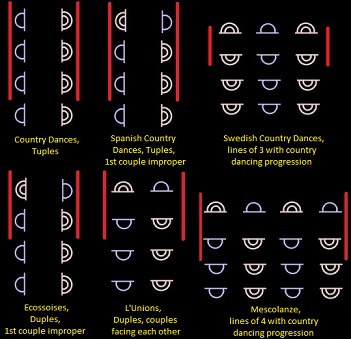
Figure 4. Country Dancing variations
Union Dance
Chivers' Danses De L'Union were (probably) a minor 1821 variation of the Quadrille Country Dance that Thomas Wilson introduced in 1819 (little evidence is available for Wilson's dance, so it's uncertain how similar they were). Chivers also invented a dance form he called the Proldrilles (The Observer, 30th January 1825). I don't know what they were, they may have been similar to the Sedrilles that were danced from around 1829 (possibly introduced by M. D'Egville, Bristol Mercury, 27th October 1829), or the Tredrilles that were introduced by Mr Bemetzrieder no later than 1830 (Manchester Courier & Lancashire General Advertiser, 7th August 1830).
Note: Chivers was an innovator and invented several new dance forms. But as with many invented dances of this era, there's little evidence of them being adopted by the wider dancing community. Provincial Dancing Masters did advertise and teach them and also claimed that they were popular in London, whereas the contemporary first hand reports of fashionable Balls and Assemblies don't tend to mention them. Perhaps the provincial dancing masters and hostesses were hoping to impress their local gentry with novelties they believed to be popular in London. For example, Chivers' Swedish Country Dances appear to have been unknown to London's publishers of annual Country Dance collections; Christopher Gerock published an ordinary Country Dance called Swedish Dance in his 1816 collection and Joseph Major published a similar The Swedish Dance in his 1820 collection, neither of which show any hints of Chiverian influence.
After nearly a decade of Chivers' dances being danced at provincial Dancing Masters' Balls, there's some evidence of them being danced in London itself in the 1830s and 1840s.
Chivers' Grand Balls
In 1820 Chivers advertised his Grand Ball. These balls were grand public affairs, open to anyone who'd purchased a ticket; they were one of the few venues at which Chivers' new dance forms could be experienced by the public. He described it as an Annual Ball , though it's unclear if any previous annual balls had been held prior to that date. The advert (The Observer, 27th February 1820) reads:
GRAND BALL at the FREEMASONS' TAVERN. Mr and Mrs CHIVERS inform the gentry that their Annual Ball will take place on MONDAY, the 6th MARCH, at the Freemasons' Tavern, Great Queen-Street. Commence at nine o'clock; and in the course of the evening Mr and Mrs C. will introduce their unique style of Waltzing; also will be introduced Le Mescolanze and a Swedish Dance. Single Tickets 7s.6d., Double Tickets 10s.6d, to be had as above, or at Mr. and Mrs. C's Salle de Danse, 7, Pickett-Place, Strand, near the Star office, where persons of any age are Taught Dancing privately. Various publications on dancing can also be had.
A year later their annual ball moved to the Crown and Anchor Tavern (The Morning Post, 1st March 1821, see Figure 5), a venue frequently used by Thomas Wilson for his public balls. Chivers' prices had gone up over the year, Single Tickets 8s.6d.; Double Tickets 12s; Party Ticket for Four, 1l.1s but remained cheaper than Wilson's equivalent prices. The program for this ball is described as: Quadrilles, Spanish Dances, Contre Danses, la Valse, and les Ecossoises. In the course of the Evening, LES LANCIERS and LES CUIRASSIERS QUADRILLES will be introduced. Also several new Species of Dancing .

Figure 5. Advert for Chivers' Annual Assembly, The Morning Post, 1st March 1821 Image © THE BRITISH LIBRARY BOARD. ALL RIGHTS RESERVED. Image reproduced with kind permission of The British Newspaper Archive ( www.britishnewspaperarchive.co.uk)
A story appeared in the Yorkshire Gazette on the 8th June 1822 reporting on a public Ball held at the Crown & Anchor Tavern (see Figure 10) in London. It could have been hosted by Chivers, or Thomas Wilson, or someone else entirely. It gives an impression of what such a ball might have been like:
The ball-room was divided into sets, and at one time upwards of 1000 persons joined in the dance. The entrance to the assembly-room was guarded by peace-officers to prevent any disorder. The interior splendid in the extreme, being illuminated with upwards of 6000 party coloured lamps, tastefully displayed in various devices. The orchestra was elevated, and consisted of a band of 18 musicians. The dances were conducted by two professional persons, who greatly conduced to the accommodation of the company. Quadrilles were the order of the night! Quadrilles at Bow Fair! Something new must be immediately invented at Almack's.
In 1823 the Ball returned to the Freemasons' Tavern. On this occasion he introduced his Son and Daughter to the public (The Observer, 20th April 1823, see Figure 7) and once again his prices had gone up.
GRAND BALL, FREEMASONS' TAVERN. Mr. CHIVERS has the honour to announce that his LAST BALL this Season will take place at the Freemasons' Tavern, on WEDNESDAY NEXT, April 23. In the course of the evening will be introduced the admired Minuet de la Cour and Gavotte, by Miss and Master Chivers; also, by particular desire, a Solo on the Violin, by Master Chivers. Single Tickets, 10s; Double Ticket, to admit a Lady and Gentleman, or two Ladies, 12s.6d. to be had at Mr. Chivers' Dancing Academy, No 7, Pickett-Place, Strand, near Temple Bar.
This advert is one of the last I can find for Chivers. A minor advert from 1824 indicates the publication of another work (The Observer, 2nd May 1824) but thereafter he almost completely disappears (as far as I can tell) from the historical record, except for one last advert in 1825. He resurfaced c.1829 to publish his Imperial Gallopades , an article that same year in the Liberal Weekly Times (1st November 1829) mentioned in passing that Chivers' old rooms at Pickett-Place have, we believe, been empty, or nearly so for some time. It's unclear why Chivers ceased advertising and publishing in 1825 or what happened to him thereafter.
There was a judicial crack-down on unlicensed dancing establishments around 1824 and several were closed. For example, The Morning Post reported on 29th December 1824 that a Mr. Jackson had had his dancing establishment raided and shut down. A similar fate befell Signor Antonio in 1825 (The Courier, 2nd September). It's possible that the shifting judicial landscape caused problems for Chivers. An obscure 1825 reference in Blackwood's Edinburgh Magazine hints that he may have gone bankrupt by that date, his academy replaced by a barber's shop:
The 'Chivers' ball-room - 'Chivers' gone away,
might hold a barber - who the rent could pay .
Chivers and Wilson
Chivers and Wilson were professionally estranged. They were in a similar business and had both previously worked at the King's Theatre Italian Opera House, a passing reference in the 1824 The Spirit of the Public Journals even mentions them both in the same sentence: ...he cannot refuse to accompany his wife and daughters to a monthly assembly at Chivers's, or Wilson's, or to an eighteen-penny hop at a tavern... (Cruickshank, 1824). A provincial dancing master called Mr Taylor advertised in 1824 that he had studied under two of the most eminent masters in London, viz, Mr. T. Wilson, late of the King's Theatre Opera House, and Mr. G.M.S. Chivers, late of the Italian Opera (Taylor had bought books from both of them and quoted liberally from them in his adverts, Staffordshire Advertiser, 10th July 1824). But despite their similarity in achievement, Chivers and Wilson were professional enemies.
Wilson's attitude towards Chivers is particularly clear in his epic 1824 poem, the Danciad. He introduced a character in this work called G.M.S. Chassee, a foolish and unprofessional dance master. It's clearly a direct and easily identifiable reference to Chivers - even a confused reviewer from the Westminster Review understood the reference (despite misidentifying Wilson entirely!). The entire work pokes ridicule at the dance teaching profession, there are especially regular and cruel references to Chivers. The following example appears to be a reference to the Minuet dancing skills of Chivers' children (who danced at the 1823 ball, see Figure 7) and their guests:
At a Grand Ball, not far from Temple Bar,
I saw some guests who did a Minuet mar;
They scraped about, as children do at school,
For bows, they hobb'd, like dab chicks in a pool:
Their arms when raised, how shall I them define?
For even Euclid has no parallel line;
...
This surely is enough to make yon say,
Let none dance Minuets, who can't grace display.
Their guests are mostly sorry sort of sparks,
Composed of prentices, and barber's clerks,
Who've never seen a Ball; nor can they show,
That they the manners of the Ball Room know;
They've only been to hops, called Balls by those
Whose aim is on all parties to impose.
At these Grand Balls I've seen strange people dance,
Not quite au fait, as I have seen in France;
But quite devoid of figures, steps, and grace,
Who know not etiquette, their side, nor place
Whose awkwardness was like, if I compare,
A stupid bear herd, and his dancing bear.
The references to Grand Balls and Temple-Bar (I've added the emphasis) above hint at the target being Chivers. Many similar passages could be quoted that similarly target, by implication, Chivers.
For example, elsewhere in the Danciad Wilson complains: No sooner had the Author announced his Waltz and Quadrille Country Dances, New Reels, Ecoissoises, and Circular Dances, than persons were found not ashamed to claim them as their own inventions, and as soon as the "Ecossoise Instructor" was published, though the system was previously unknown, yet another Ecossoise Instructor immediately appeared at half the original price . It's probable that Chivers is the unnamed protagonist and Wilson felt Chivers had been stealing from him.
Wilson also wrote an extended commentary on Chivers as a Professor of Dancing in the 1820 edition of his Complete System of English Country Dancing. The essay, entitled Teachers (part of which is quoted above) suggests that Chivers was a charlatan, it also contains an account that intended to demonstrate that Chivers was unable to teach a Bolero dance. It's unclear whether Chivers and Wilson had professional dealings prior to publication of Wilson's Complete System but Wilson's attack clearly ended any hope of a professional camaraderie.
Chivers took his own opportunities to attack Wilson. He'd found a quotation in James Cassidy's 1810 Treatise on the Art of Dancing in which Cassidy dismissed Wilson's 1809 Treasures of Terpsichore as unintelligible and useless . Chivers quoted this passage in his 1821 Dancers' Guide, presumably in response to Wilson's attack, and again in his 1822 Modern Dancing Master. Wilson also promoted a style of Country Dancing that Chivers described as being evidently wrong in his 1818 Companion to the French and English Country Dancing; Chivers was almost certainly referring to Wilson when he wrote of this style of dancing in his 1821 Dancer's Guide that some teachers will still persist in their old plan, because they are ashamed to acknowledge their error .
Chivers and Wilson both taught Circular dances in 1822. Chivers taught his Chivonian Circles, Wilson taught his Arcular Quadrilles and Circular Quadrilles. They both claimed to have invented the concepts. Wilson published his Circular System of English Country Dancing in 1818, that does seem to have influenced the Chivonian Circle (and Bemetzrieder's Circassian Circle), so there is some evidence to support Wilson's claim.
Chivers' Union dances appear to have used exactly the same format as Wilson's Quadrille Country Dances. Wilson prepared his Quadrille Country Dance Preceptor for publication in 1820, Chivers may have taught his Union dances from around the same date, certainly no later than 1821. They both claimed to have invented these dances. The earliest reference I've found to the publication of Quadrille Country Dances is from 1817 at Fentum's music shop (Morning Chronicle, 15th December), I don't have access to Fentum's collection to verify their content but it's quite possible that neither Wilson nor Chivers were the first to invent this hybrid dance. An 1826 report in The Morning Post (21st January) indicates that Quadrille Country Dances were being danced at Almack's Assembly Rooms that year.
Queering the Quadrillers
It's unusual to find a contemporary description of an 1820s dancing assembly but in the case of Chivers we have a partial (and colourful) description.
The following amusing tale comes from Bell's Life in London and Sporting Chronicle, 19th January 1823. It doesn't mention Chivers by name but does refer to his premises in Pickett-Place. It's unclear quite how seriously this little story should be taken. Regardless of the anecdotal nature of the report, it offers some insight into the daily operation of Chivers' Academy and the Academy's clientele. The story reads:
QUEERING THE QUADRILLERS; OR, A NEW STEP TO BOW-STREET.
One Solomon Dobbs, an operative tailor all fudge and fooster, like a superannuated goose, was charged by a very spruce young Gentleman, with raising a false alarm against him, whereby he, the young Gentleman, was in imminent danger of being treated as a pickpocket, or something of that sort.
The young Gentleman, whose name we understood to be Henry Augustus Jinks, was proceeding to his studies in quadrilling at the dancing academy in Pickett-place, Temple-bar, about nine o'clock on Wednesday evening; and being thinly clad in silken hose, and all that, he was hurrying along to keep himself warm and comfortable. Whilst he was hurrying along, thinking of nothing at all but the forthcoming quadrille, he heard somebody behind him cry stop! and looking back he saw Mr. Solomon Dobbs waddling after him. Mr Henry Augustus Jinks had no idea that the cry could be addressed to him, and so continued to run on; but Mr. Solomon Dobbs still waddled after him, exclaiming stop him! stop that thief, &c. though in such a thick husky voice that nobody noticed him. Neither did Mr. Henry Augustus Jinks notice him; and the first quadrille - which had been only waiting for him, was just about to be led off, when in pops Mr. Solomon Dobbs and seizes Mr. Henry Augustus Jinks by his clean cravattery! to the great terror of the Ladies, the indignation of the Gentlemen, the silencing of the fiddlers, and total disarrangement of the quadrille. This was shocking enough in all conscience; but how was the terror and indignation increased when Mr. Solomon Dobbs, still holding the astonished Mr. Henry Augustus Jinks by his clean cravat, told him in plain terms, that he was a pickpocket, and had robbed him of his watch. It was too much. The Ladies squeeled, the Gentlemen stormed, Mr. Henry Augustus Jinks threatened an action for slander, the Master of Ceremonies ran for a watchman, and Mr. Solomon Dobbs was carried off to the watch-house as a dangerous and evil-minded disorderly.
The magistrate called upon Mr. Solomon Dobbs for an explanation of his strange conduct.
--- And please your Worship, I was not so sober as I might have been, replied Mr. Solomon Dobbs, as solemnly as possible.
Had you any ground for the charge you made against this young Gentleman? asked the Magistrate.
Your Worship, I had not; and I really have no recollection of having done what is laid to my charge, replied Mr. Solomon Dobbs in deep despondency.
Then, by your own confession, you are a drunken fool, responded his Worship.
Mr. Solomon Dobbs bowed assent.
Mr. Henry Augustus Jinks said he was satisfied, and the matter was dismissed.
Presumably the unnamed Master of Ceremonies was Chivers himself. Figure 8 is an unrelated 1817 image of a Quadrille party suffering an unfortunate accident, it seemed suitable to illustrate the misadventure of Jinks and Dobbs.

Figure 9. Chivers' publications, c.1823, as advertised in his New Set of Contre Danses.
Image © BRITISH LIBRARY BOARD, h.1480.t.(11.) ALL RIGHTS RESERVED
Chivers' Quadrilles
Chivers is perhaps best known as a creator of Quadrille dances. He published several sets of enduring popularity, including the Cuirassiers and the Caledonians - both were included in various Quadrille Preceptors by other publishers, such as the The Complete English Quadrille Preceptor for 1823.
We've previously investigated Chivers' Original Lancers and how they relate to similar sets published by John Duval and Joseph Hart. Chivers' often prefixed the names of his Quadrilles with the word Original , perhaps as a form of branding. A previous article noted that Chivers supplied some of the figures for Hart's 3rd Set of Scotch Quadrilles (c.1822) and Hart's 4th Set of Scotch Quadrilles (c.1823) and went uncredited for supplying the figures for Hart's 2nd Set of Scotch Quadrilles (1822).
It's possible that Chivers and Hart had a more significant relationship. Joseph Hart was a musician and band leader, not a dancing master, yet he published new figures with many of his Quadrilles. It's possible that Chivers helped to supply those figures. Several of Chivers' later publications appear to include figures from Hart's Quadrilles: the 1824 Quadrille Preceptor contained figures for Hart's Hussars (1820); the 1825 Annual Quadrille Preceptor may have contained figures for Hart's 10th Set (1823) and the 1825 Dancing Master in Miniature may have contained figures for Hart's Tempete Dance (c.1820).
The price list in Figure 9 shows that Chivers' Caledonian Quadrilles had reached their 4th edition by around 1823. Many other publishers also produced Quadrilles themed around Scotland in the 1820s, including Hart, Gow (actually several Gows), Hodsoll and MacDonald. Chivers appears to have initiated the trend. Figure 9 also shows some of the many other Quadrille Sets Chivers published, including his Moscovian Waltz Quadrilles.
Chivers' Publications
Dating Chivers' diverse publications has proven challenging. A few of them are explicitly dated, several more are referenced in adverts or other dated publications. But several were republished multiple times such that the second edition of an earlier work may reference the first edition of a later work. Most of his minor works were included within the major works and were also available separately, this confuses and extends the list of publications.
The table below documents the chronology of publications. There may be gaps but it includes everything I've been able to identify. Many of these works were published in a miniature format which (I presume) minimised the printing costs, in some cases the books are only an inch or two wide. The price of the works seems to have been based on the quantity of paper used in their printing, not the quantity or quality of the content. Works of small physical dimensions could be cheaper than full sized publications with less content.
I'd like to thank the British Library for providing their permission to share most of these images.
| Work & Date | Image | Comments |
A Companion to the French and English Country Dancing
1818 |
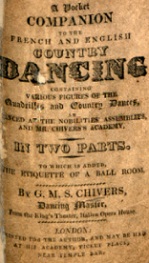
|
This pocket sized work is in two parts. The first part documents seven sets of Quadrilles danced at Almack's and three new Sets of Quadrilles by Chivers. The second part documents 60 sets of country dancing figures that can be adapted to any tune. This second part is similar to (and perhaps derived from) Edward Payne's 1814 Companion to the Ball Room.
This work is mentioned in Chivers' 1818 advert in The Morning Post (13th November). It's also mentioned in a list of new works in the 1818 British Review and London Critical Journal.
Full Title: A Pocket Companion to the English and French Country Dancing. Containing various figures of the Quadrilles and Country Dance, as danced at the Nobilities Assemblies and Mr Chivers Academy, in two parts. To which is added, The Etiquette of a Ball Room, by G.M.S. Chivers, Dancing Master, from the King's Theatre, Italian Opera House.
Image © BRITISH LIBRARY BOARD, 1041.b.29.(1) ALL RIGHTS RESERVED
|
Swedish Dances
1818 |
|
This work describes Chivers' Swedish Country Dances. It's mentioned in Chivers' 1818 advert in The Morning Post (13th November). The text, presumably of this work, is included in several subsequent publications. It cost 2s.
|
An Instructor to the Swedish Dances and Mescolanzes
1819 |
|
This work was advertised in The Observer, 23rd January 1820. It cost 4s. The advert indicates the former is adapted for parties having a majority of either sex, and the latter unites the Quadrilles and Contre Danses into one species .
The Mescolanze Instructor was also available separately for 2s.
|
Recueil de Danses Espagnoles
1819 |

|
This work was advertised in The Observer (23rd January 1820) and in The New Monthly Magazine in 1819. It cost 3s and was subtitled Spanish Country Dancing made plain and easy . It also contained a complete dictionary of all the technical terms made use of in the Spanish Dances . The earliest documented references I know of to Spanish Country Dances in Britain are those of Edward Payne, though the dances may well originate in Spain.
Full Title: Recueil de Danses Espagnoles, or Spanish Country Dancing made plain and easy; together with several new dances, original figures, and their proper directions, in Spanish and English; as performed at the author's academy, and at the nobility's assemblies, arranged for the piano-forte, harp, or violin. Composed and selected by G.M.S. Chivers, Dancing Master, inventor of Le Mescolanze - Swedish Country Dances. &c.. To which is added, An Explanation of the Spanish Technical Terms, and the construction of those fashionable dances.
Image © BRITISH LIBRARY BOARD, e.109.(1) ALL RIGHTS RESERVED
|
Companion to les Ecossoises
1819 |
|
This work was advertised in The Observer, 23rd January 1820. It cost 1s.6d, a price Wilson complained was calculated to undercut his own 1817 Ecossoise Instructor.
|
La Grande Polonaise
1821 |
|
This work was advertised as just published in The Morning Post, 1st March 1821. It cost 2s.
|
Les Danses de L'Union
1821 |

|
This work was advertised as just published in The Morning Post, 1st March 1821. It cost 2s.
Full Title: A Companion to Les Danses De L'Union, containing directions for performing those nouvelle danses; also a variety of figures, and an explanation how to select your own music, &c.. By G.M.S. Chivers, Dancing Master.
Image © BRITISH LIBRARY BOARD, e.109.(2.) ALL RIGHTS RESERVED
|
Cuirassiers Quadrilles
1821 |
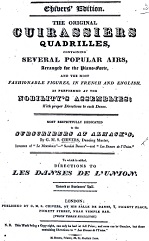
|
This work was advertised as just published in The Morning Post, 1st March 1821. It cost 3s and was subsequently republished multiple times. It's the first of many Quadrille Sets Chivers published themed around Cavalry. This is presumably a response to the dramatic success of the Lancers Quadrilles by John Duval and Joseph Hart.
The Quadrilles are: L'Auguste, La Laure, La Louise, Di Tanti Palpiti and La Nouvelle Fantasia. Most of the figures come from the First Set but the Finale may have been new.
The Spanish composer Ferdinand Sor also published his first set of Cuirassiers Quadrilles in 1821. They appear to be unrelated.
Full Title: The Original Cuirassiers Quadrilles, containing several popular airs, arranged for the piano-forte, and the most fashionable figures, in French and English, as performed at the nobility's assemblies; with proper directions to each dance. Most respectfully dedicated to the subscribers at Almack's, by G.M.S. Chivers, Dancing Master, inventor of Le Mescolanze, Swedish Dances, and Les Danses de l'Union . To which is added, directions to Les Danses de L'Union.
Image © BRITISH LIBRARY BOARD, e.109.(2.) ALL RIGHTS RESERVED
|
The Dancers' Guide
1821 |

|
This work was advertised as just published in The Morning Post, 1st March 1821. It cost 3s.6d, in a pocket sized format and included the text of many of the previous works. This was Chivers' most significant work up to this date. A second edition was published c.1823 under the title The New Dancers' Guide.
Some of the text of the essays is derived from his Companion to the French and English Dancing, other text is derived from the works of Wilson and Payne. Other text is derived from the essays of Gallini and elsewhere. The essays went on to be republished in a longer and more polished form in The Modern Dancing Master.
Full Title: The Dancers' Guide. Contains an explanation of technical terms, also explains the manner of performing the Quadrilles, Ecossoises, Swedish and Spanish Dances, Mescolanzes, and the Contre Danses, together with all the most fashionable figures, and the position of the dancers previous to their commencing either of the above six different species of dancing, is clearly shown, to which is added The Etiquette of a Ball-Room, observations on deportment, origin, antiquity and utility of the polite art of dancing. By G.M.S. Chivers, dancing master from the Italian Opera House, author of various publications: Instructor of the Mescolanzes, Swedish Dances, &c.
Image © BRITISH LIBRARY BOARD, 1041.b.29.(2.) ALL RIGHTS RESERVED
|
Caledonian Quadrilles
c.1821 |
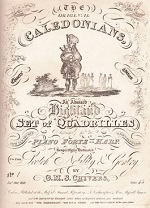
|
The second edition of this work was advertised in The Morning Post, 21st February 1822. It cost 2s.6d and was described as the admired Highland Quadrilles . This set of Quadrilles went on to (arguably) become Chivers' most successful work.
The Quadrilles are: My Love She's But A Lassie Yet, Logie of Buchan, Banks of the Dee, When I Parted and Gordon of Lesmor.
An 1826 advert in The Harmonicon for the Caledonians adds: Order Chivers's edition of these favourite Quadrilles, as many spurious copies are daily foisted on the Public .
This is one of the first of a number of 1820s Quadrille Sets to be published on a Scottish theme. The figures of this Quadrille Set remained popular for many years, they were only slightly less popular than those of The Lancers. Joseph Hart may have published his 1st Set of Scotch Quadrilles before the publication of Chivers' Caledonians, the timing isn't certain.
Thomas Wilson had a poor opinion of these Quadrilles, he wrote in his 1824 Danciad: There are several sets of what are termed "Scotch Quadrilles," which are only Scotch as to name and tune, having no other national characteristic, being composed of French Quadrille figures and steps. In order to enable those who are conversant with Scotch dancing, to judge how far these are entitled to the appellation of Scotch, the reader is here presented with the figures of The Caledonians. . Wilson went on to share the figures of The Caledonians and his own Scotch Quadrilles with figures he thought were more Scottish in character.
|
The Modern Dancing Master
1822 |

|
This was Chivers' great work, containing the text of most previous works and a picture of the author. His earlier essays in The Dancers' Guide were expanded or reworked for this publication. It cost 15s.
Much of the content was also made available separately, though the precise chronology of publication isn't clear. This work also contains several Sets of Quadrilles, most of which were published as separate works, one may not have been. These are:
- The Original Parisians
- The Original Buffetiers
- The Original Cuirassiers
- The Original Lancers
- The Original Privateers
- The Original Carbineers
- The Original Caledonians
- The Original Moscovians
The British Library have shared a few pages of this book online.
Full Title: The Modern Dancing Master; containing interesting information on the origin and antiquity of dancing; likewise observations on deportment; shewing the defects and bad habits persons are liable to; and the utility of the polite art, and its power on man and animals; together with La Grande Polonaise, Les Ecossoises, Mescolanzes, Swedish Dances, Quadrilles, Spanish Dances, Contre Danses, L'Union Danses, and various other departments, containing all the fashionable figures, with an explanation of the technical terms to each of the different styles of dancing, and nearly one hundred of the most popular airs, arranged for the piano forte, harp, violin, or flute, by G.M.S. Chivers, formerly of the King's Theatre. Inventor of Le Mescolanze, Swedish Dances, L'Union Danses, &c. To which is added sixteen divisions of waltzing.
Image © BRITISH LIBRARY BOARD, 558*.c.40 ALL RIGHTS RESERVED
|
Chivonian Circle Explained
c.1822 |
|
This work was included within The Modern Dancing Master. It was also available separately for 2s, according to a c.1823 advert of Chivers' publications included in his Collection of Contre Danses (see Figure 9).
Chivers pre-advertised a work also for the press within his 1821 Dancers' Guide called the New Circular Quadrilles . It's unclear if that work was ever published. It's likely that it evolved into this publication and was included with the Modern Dancing Master.
|
Observations on Deportment
c.1822 |
|
This work was included within The Modern Dancing Master. It was also available separately for 2s, according to a c.1823 advert of Chivers' publications included in his Collection of Contre Danses (see Figure 9).
|
Sixteen Divisions of Waltzing
c.1822 |
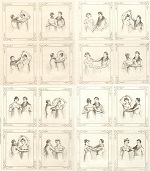
|
These waltzing images were engraved by J. Findley and were included as a suffix to The Modern Dancing Master. They were also available separately for 2s, according to a c.1823 advert of Chivers' publications included in his Collection of Contre Danses (see Figure 9).
Image © BRITISH LIBRARY BOARD, 558*.c.40 ALL RIGHTS RESERVED
|
Etiquette of the Ball Room
c.1822 |
|
This work was included within The Modern Dancing Master. It was also available separately for 1s, according to a c.1823 advert of Chivers' publications included in his Collection of Contre Danses (see Figure 9).
|
Parisian Quadrilles
c.1822 |
|
This work was included within The Modern Dancing Master. It was also available separately for 2s, according to a c.1823 advert of Chivers' publications included in his Collection of Contre Danses (see Figure 9). The contents are the dances of the First Set.
The Quadrilles are: Le Pantalon, L'Ete, La Poule, La Trenise and La Finale.
|
Moscovian Quadrilles
c.1822 |
|
This work was included within The Modern Dancing Master. It was also available separately for 3s, according to a c.1823 advert of Chivers' publications included in his Collection of Contre Danses (see Figure 9). The contents are a set of Waltz Quadrilles , at least two editions were published.
The Quadrilles are: The Guaracha Waltz, The Tyrolese Waltz, The National Waltz and The Stop Waltz.
|
Lancers Quadrilles
c.1822 |
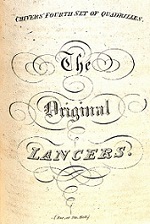
|
This work was included within The Modern Dancing Master. It was also available separately for 2s, according to a c.1823 advert of Chivers' publications included in his Collection of Contre Danses (see Figure 9).
The Quadrilles are: La Rousseau, La Parmesane, The Dorset, L'Amusette and De Berri.
This Set are ultimately derived from Duval's 1817 Second Set of Quadrilles, which are discussed further here. Chivers' version appears to be derived from the 1820 variation published by Joseph Hart, though it's possible that Chivers and Hart collaborated on that work together.
Image © BRITISH LIBRARY BOARD, 558*.c.40 ALL RIGHTS RESERVED
|
Privateers Quadrilles
c.1822 |
|
This work was included within The Modern Dancing Master. It was also available separately for 3s, according to a c.1823 advert of Chivers' publications included in his Collection of Contre Danses (see Figure 9).
The Quadrilles are: Lodoiska, La Poule Anglaise, La Tambour de la Garde, Vestris Favorite and La Carinthia.
|
Carbineers Quadrilles
c.1822 |
|
This work was included within The Modern Dancing Master. It was also available separately for 2s, according to a c.1823 advert of Chivers' publications included in his Collection of Contre Danses (see Figure 9).
The Quadrilles are: La Pauline, L'Amiable, La Belle Flamand, La Favorite and La Belle Sergent.
|
A Second Set of L'Union Danses
c.1823 |
|
This work cost 4s. It wasn't referenced in the 1822 The Modern Dancing Master but is included in the c.1823 advert of Chivers' publications included in his Collection of Contre Danses (see Figure 9). It is said to have included Four popular sets of Quadrilles .
Full Title: A second set of figures to L'union danses, with proper directions to each dance & every explanation requisite for performing them. To which is added four popular sets of quadrilles, entitled Cuirassiers, Privateers, Caledonians & the Parisians, arranged for the piano forte, harp or violin, by G.M.S. Chivers.
|
Hibernian Quadrilles
c.1823 |
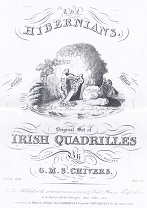
|
This work cost 3s. It wasn't referenced in the 1822 The Modern Dancing Master but is included in the c.1823 advert of Chivers' publications included in his Collection of Contre Danses (see Figure 9).
The Quadrilles are: De Clifford, Duke of Norfolk, Earl Belmore, Marchioness of Conyngham & Marchioness of Londonderry.
Full Title: The Hibernians. Chivers Edition. An original Set of Irish Quadrilles with entire new figures, by G.M.S. Chivers.
Image © BRITISH LIBRARY BOARD, h.1480.t.(9.) ALL RIGHTS RESERVED
|
Chiverian Quadrilles, First Set
c.1823 |
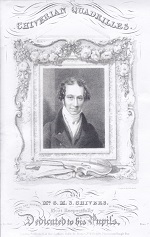
|
This work cost 3s. It wasn't referenced in the 1822 The Modern Dancing Master but is included in the c.1823 advert of Chivers' publications included in his Collection of Contre Danses (see Figure 9).
The Quadrilles are: L'Amour du Village, Le Garcon d'Irlande, La Venitienne, Le Barbier de Seville & La Cendrillon.
Full Title: First Set of Chiverian Quadrilles. By Mr. G.M.S. Chivers, with new figures in French & English, most respectfully dedicated to his pupils.
Image © BRITISH LIBRARY BOARD, h.104.(1.) ALL RIGHTS RESERVED
|
Chiverian Quadrilles, Second Set
c.1823 |
|
This work cost 3s. It wasn't referenced in the 1822 The Modern Dancing Master but is included in the c.1823 advert of Chivers' publications included in his Collection of Contre Danses (see Figure 9). It's not listed in an earlier version of the same advert published with his First Set of Chiverian Quadrilles, so it was presumably published late in 1823, or early 1824.
|
Royal Stars Quadrilles
c.1823 |
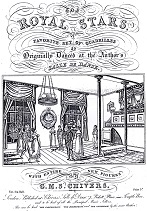
|
This work cost 3s. It wasn't referenced in the 1822 The Modern Dancing Master but is included in the c.1823 advert of Chivers' publications included in his Collection of Contre Danses (see Figure 9). It's not listed in an earlier version of the same advert published with his First Set of Chiverian Quadrilles, so it was presumably published late in 1823, or early 1824.
The Quadrilles are: George IV, Princess Sophia, William Henry, Duke of Clarence, Augustus Frederick, Duke of Sussex & Frederick, Duke of York.
Full Title: The Royal Stars. A favorite set of Quadrilles as originally danced at the author's Salle de Danse. With entire new figures, by G.M.S. Chivers.
Image © BRITISH LIBRARY BOARD, h.1480.t.(12.) ALL RIGHTS RESERVED
|
A Case of Quadrille Cards
c.1823 |

|
Chivers sold Quadrille Cards in French and English from at least 1821. He advertised an entire collection of them for 4s in his Collection of Contre Danses (see Figure 9). These tiny cards form a convenient collection that can be carried around in a reticule, they helped to avoid the embarrassment of forgetting the figures when dancing a choreographed Quadrille dance.
The collection was said to include all the popular Sets . These cards are similar to sets we've previously investigated featuring the Quadrilles of Edward Payne and James Paine. They were printed for Chivers and heavily feature the Quadrilles that he himself published.
A similar advert in the 1824 Quadrille Preceptor mentioned a case of Quadrille Cards Containing upwards of Sixteen Sets of Quadrilles; also popular Figures to L'Union, Spanish and English Contre Danses, &c. with leater case, price 4s .
Candice Hern, author of numerous Regency Romance novels, owns a later collection of Chivers' Quadrille Cards that I suspect date to around 1828. She very kindly allowed me to inspect them. Most of the Quadrilles featured were published by Chivers himself (including almost everything from the 1824 Quadrille Preceptor), together with the Quadrilles of Paine and Hart. The collection does include a couple of Quadrille Sets I'm not otherwise familiar with: the Ladies' Quadrilles and Dale's Second set of Cuirassier Quadrilles.
Image courtesy of Candice Hern
|
New Set of Contre Danses
c.1823 |
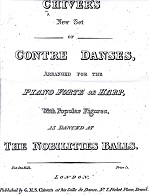
|
This work cost 2s.6d. It wasn't referenced in the 1822 The Modern Dancing Master. An advert in the back of this collection lists many of Chivers' works but doesn't include his 1824 Quadrille Preceptor (though that work does reference this one, quoting the price at 1s). This suggests that it was probably published in 1823. Most of the advertised works were included in The Modern Dancing Master.
The Contre Danses themselves are a fairly ordinary set of Country Dances. The music is reused from Chivers' various c.1823 Quadrilles.
Full Title: Chiver's New Set of Contre Danses, arranged for the piano forte or harp, with popular figures, as danced at the nobilities balls.
Image © BRITISH LIBRARY BOARD, h.1480.t.(11.) ALL RIGHTS RESERVED
|
Quadrille Preceptor
1824 |
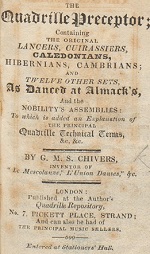
|
This work was advertised as just published in The Observer, 2nd May 1824. It was a miniature publication (approximately 1.5 inches by 3 inches) and cost 1s.
The contents are made up of the following Quadrille Sets:
- Nine sets of Parisian Quadrilles, as Danced at Almack's
- The Lancers, as Danced at the Fashionable Assemblies
- The Caledonians, as Danced at the Fashionable Assemblies
- The Hibernians, as Danced at the Fashionable Assemblies
The Royal Cambrians, as Danced at the Fashionable Assemblies , this is probably the Set published by John Parry in 1822.
- The Hussars, as Danced at the Fashionable Assemblies (Hart's 3rd Set of Quadrilles)
- The Cuirassiers, as Danced at the Fashionable Assemblies
- The Royal Stars, as Danced at the Fashionable Assemblies
- Chiverians (First Set), as Danced at the Fashionable Assemblies
- Chiverians (Second Set), as Danced at the Fashionable Assemblies
Image © BRITISH LIBRARY BOARD, T.1208.(14.) ALL RIGHTS RESERVED
|
Second Set of Caledonian Quadrilles
1824 |
|
This work was advertised as just published in The Observer, 2nd May 1824. It cost 3s.
|
Annual Quadrille Preceptor
1825 |
|
This work was advertised as just published in The Observer, 30th January 1825. It was a miniature publication and cost 1s.
The advert indicates that it contains Der Freischutz, and all the popular sets for 1825, price 1s . It's presumably is a second edition of the 1824 Quadrille Preceptor, with additional content. Several publishers produced Quadrilles based on Weber's Der Freischutz , the best known was Joseph Hart's 1823 10th Set of Quadrilles.
|
The Dancing Master in Miniature
1825 |
|
This work was advertised as just published in The Observer, 30th January 1825.
The advert indicates that it contains a new set of Proldrilles, the Circular Saraband, Tempete Dance, Circassian Circle, and various other Dances, as now performing at the London Assemblies . Much of this content was new, it hadn't been included in the 1822 Modern Dancing Master.
I've no idea what Proldrilles are, they are probably a new term invented by Chivers, perhaps similar to the Sedrilles . If so, it's likely to be a hybrid dance, such as a Waltz Quadrille, or a variant of the Sixdrille . The Circular Saraband is probably also a Chiverian invention, though the Sarabande itself was a Minuet-like baroque dance. Joseph Hart published a Tempete dance c.1820 and the Circassian Circle (originally by Mr. Bemetzrieder) was included in the Modern Dancing Master.
|
Third Set of Caledonian Quadrilles
1828 |
|
An advert in The Edinburgh Review for January 1828 indcates that the third set were in the press . It also advertised the third edition of the first set of Caledonians.
|
Imperial Gallopades
c.1829 |
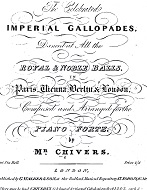
|
Chivers published this set of Gallopades around 1829, at the same time as several similar works by other publishers, including the Royal Gallopades of Joseph Hart. It cost 2s.6d.
Full Title: The Celebrated Imperial Gallopades, danced at all the Royal & Noble Balls, in Paris, Vienna, Berlin & London, composed and arranged for the Piano Forte, by Mr. Chivers.
Image © BRITISH LIBRARY BOARD, h.1480.t.(10.) ALL RIGHTS RESERVED
|
And then...

Figure 10. A Ball at the Crown & Anchor Tavern, potentially hosted by Chivers, Yorkshire Gazette, 8th June 1822. Image © THE BRITISH LIBRARY BOARD. ALL RIGHTS RESERVED. Image reproduced with kind permission of The British Newspaper Archive ( www.britishnewspaperarchive.co.uk)
Chivers seems to have ceased advertising and publishing around 1825. His insurance records from 1825 indicate his occupation to be Publisher of Music , the equivalent records for 1820 list his occupation as Dancing Master . This suggests that he may have taken the same retirement strategy as James Paine and settled down to running a music shop. I have very little evidence of his existence after 1825, other than the last few publications that appeared in the late 1820s.
Chivers' influence was still spreading in 1825. A report in the Lancaster Gazette (14th May) indicates that the Lancastrian dancing master Mr Winder was teaching the dances of Chivers, T.W. Lloyd and others. Winder's repertoire included Circassian Circles, the Mescolanze Dance, the Tempete Dance, the Circular Saraband, La Pruvinal and more. Winder claimed to have learnt them from a business partner who was lately returned from London . It's likely that the partner brought a copy of Chivers' 1825 Dancing Master in Miniature home with him, it formed a core part of Winder's repertoire. Later that year Winder's adverts were updated to also mention Chivers' Swedish Dances (Westmorland Gazette, 31st December 1825).
Note, if you'd like to know more about the family of Winder dancing masters in Lancashire, I can recommend Andy Hornby's The Winders of Wyresdale. This book includes a study of the Country Dancing music known to have been in the possession of the Winder family and offers a fascinating insight into their life and work.
Mr Woakes of Hereford mentioned Swedish Dances several times in his 1825 Essay on the Attitudes (a work largely derived from Chivers' own publications). Mr Macindoe in Glasgow advertised in 1826 that he taught the much admired L'Union Circassian Circles, invented by Mr. Chevers, of London - a style of Country Dancing which is very pleasing, and easily understood by those who have been taught Quadrilles (Glasgow Herald, 29th December 1826). Mr Garnett included several of Chivers' dances in his 1828 Ball at Bowness, including both Miscolanze and Swedish Dances . Mr Robinson taught both Swedish Dances and Mescolanze in 1831 (Newcastle Courant, 20th August), and M. Rochefort taught the Cuirassier Quadrilles, also in 1831 (Newcastle Courant, 15th January). Mr Lee was teaching Swedish & Spanish Dances, Miscolanze, Circassian Circle, &c. in 1833 (Leamington Spa Courier, 11th May). It's likely that Chivers' dances had far greater success outside of London than they ever had at home.
Occasional later references to Chivers' dance forms can be found. In 1841 the Ancient Order of Druids held a Ball at their Grand Lodge that featured Chivers' Mescolanze dances (The Era, 21st February 1841). In 1857 the Hormby Commemoration Ball also featured a Mescolanze (Blackburn Standard, 3rd June 1857).
From 1822 the Lowe Brothers of Scotland were teaching and promoting Chivers' dances. Details of the Mescolanze were included in the second edition of Lowe's Ball Room Conductor (Glasgow Herald, 29th November, 1822). A Glaswegian newspaper called The Ant reported in 1829 that they were also teaching the Chivonian Circle. Their Quadrille Preceptor continued to feature Mescolanze dances in 1838. W. Smyth included the Mescolanze in the 1830 second edition of his A Pocket Companion for Young Ladies and Gentlemen (it was published in Edinburgh). J.S. Pollock included several of Chivers' dances in his c.1830 Terpsichore Moderne, including the Mescolanze and Swedish Country Dances. Some of Chivers' Quadrilles remained popular for many years to come, most notably his Caledonian Quadrilles - editions were still being advertised using Chivers' name as late as 1847 (London Daily News, 26th February). A few of Chivers' dances remained in circulation long after he had ceased to promote them himself.
And here ends our investigation into the life and works of George Chivers. If you have any information to further amplify these themes, do please get in touch. Very few of his publications are currently available online, so if you're lucky enough to have something to share, I'm sure the community would welcome it. I'd be particularly thrilled if some of his lost works could be found!
If you'd like to dance some of his published dances, you'll find a few of them animated here at RegencyDances.org. Others are examined in Volume VII of John Gardiner-Garden's epic Historic Dance series.
|


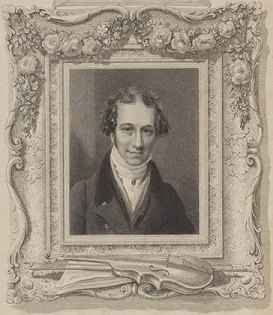 Figure 1. Portrait of G.M.S. Chivers, from his 1822 Modern Dancing Master
Figure 1. Portrait of G.M.S. Chivers, from his 1822 Modern Dancing Master
 Figure 2. Advert for Chivers' Academy, The Morning Chronicle, 4th March 1819
Figure 2. Advert for Chivers' Academy, The Morning Chronicle, 4th March 1819  Figure 3. A dance similar to a Swedish Country Dance, from Étrennes à Terpsichore,
Marque, 1821.
Figure 3. A dance similar to a Swedish Country Dance, from Étrennes à Terpsichore,
Marque, 1821.
 Figure 4. Country Dancing variations
Figure 4. Country Dancing variations
 Figure 5. Advert for Chivers' Annual Assembly, The Morning Post, 1st March 1821
Figure 5. Advert for Chivers' Annual Assembly, The Morning Post, 1st March 1821 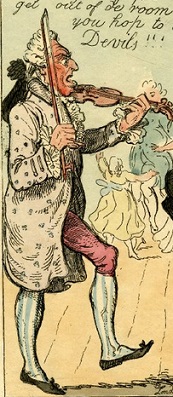 Figure 6. Detail from The Enraged Dancing Master, I. Cruikshank, 1803.
Figure 6. Detail from The Enraged Dancing Master, I. Cruikshank, 1803.
 Figure 7. Chivers' Grand Ball, The Observer, 20th April, 1823 (Courtesy of NewspaperArchive.com )
Figure 7. Chivers' Grand Ball, The Observer, 20th April, 1823 (Courtesy of NewspaperArchive.com )
 Figure 9. Chivers' publications, c.1823, as advertised in his New Set of Contre Danses.
Figure 9. Chivers' publications, c.1823, as advertised in his New Set of Contre Danses.
 Figure 10. A Ball at the Crown & Anchor Tavern, potentially hosted by Chivers, Yorkshire Gazette, 8th June 1822.
Figure 10. A Ball at the Crown & Anchor Tavern, potentially hosted by Chivers, Yorkshire Gazette, 8th June 1822.